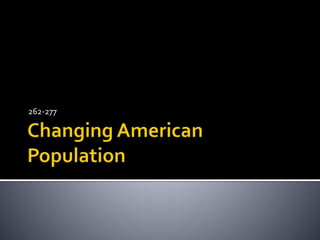
The Changing American Population (1800-1860)
- 1. 262-277
- 2. Reasons: Booming agricultural economy of the west ▪ Cities became centers of trade (p. 263 shows examples) Improvements in public health ▪ Birth rate was lower ▪ Death rate was far lower, allowing for population increase Immigration ▪ Growth of cities was dramatic between 1840-1860 ▪ Most immigrants from Germany & Ireland ▪ P. 263 shows city growth examples
- 4. A defense of native-born people and a hostility to foreign-born Also a desire to slow immigration Examples: Nativists would say that new immigrants were inferior to older Americans Saw them as about the same as Native Americans They would say that immigrants were socially unfit Some said immigrants stole jobs from workforce & lowered wages
- 6. Native American Party: 1837 Anti-immigration group Held their own convention in 1845 Know-Nothings: 1845-1850 First called “Supreme Order of the Star-Spangled Banner” Banned Catholics from holding public office, restrictive naturalization laws, literacy tests for voting among their demands
- 7. Know-Nothings led to American Party in 1852 in the west They actually won control of MA state gov’t in 1854, won large number of seats in PA and NY This was the peak of their power
- 8. Canal Age: 1790-1820s=“turnpike era” By 1820s new means of transportation Steamboats, esp. Mississippi & Ohio Rivers Used commercially & for passengers By 1820s states turned to building canals Cheaper & quicker Erie Canal across NY (1817-1825) 363 miles long, longest canal previously=28 miles Linked NYC to Chicago & Great Lakes
- 9. Erie Canal’s success led to a canal building boom (see map on p. 271) Connection between Lake Erie & Ohio River Led to increased settlement in Northwest Others failed in building successful canals
- 10. Early Railroads: 1804: inventors had been experimenting with steam engines for land vehicles 1820: first locomotive is run around a track (NJ) 1825: first RR line opened in England First company: Baltimore and Ohio, 1830 ▪ Peter Cooper & Tom Thumb (see picture on p. 272) By 1836, 1,000+ miles of track had been laid in 11 states
- 11. Railroads: Were short Connected water routes No linkage of one RR company to another Track sizes (gauges) were not uniform Schedules did not match Constant wrecks! In competition w/ canals Slow improvements in 1830’s
- 12. Triumph of RR: By 1860, there was almost 30,000 miles of track Most was in northeast but reached far and wide See map on page 273!!
- 13. Time to travel from New York to various locations Maps from the 1932 Atlas of the Historical Geography of the United States
- 16. Linkage of lines to make RR lines longer Lots of examples on page 272 Lines would divert traffic from Erie Canal and Mississippi River Chicago becomes the rail center of the West RR’s helped weaken the connection between the Northwest and the South (dependency on Mississippi River lessens)
- 17. Several sources: Private American investors RR companies borrowed large sums of $$$ Local governments, states, counties, cities, towns Federal gov’t ▪ Congressional grants to aid RR’s in 11 states by 1860 ▪ 30 million + acres of land ▪ Rail companies earn huge profits & accumulate enormous strength
- 18. Telegraph: Samuel Morse, 1844 ▪ 1st message, from Baltimore to Washington D.C.=“What Hath God Wrought?” Transmitted from Baltimore to Washington, D.C. Low cost system of communication 50,000 miles of wire connected by 1860 coast to coast
- 19. More About Morse Code More About Morse Code
- 20. Steam cylinder rotary press Associated Press
- 21. Things to consider: (p. 275) Retail distribution of goods changed Growth of corporations began here ▪ What is a corporation? Limited liability ▪ What does this mean? Credit was a way to borrow, but bank did not have enough equity to support the borrowing Bank failures were frequent
- 22. By far the biggest economic development of the mid-19th century Started with textile industry, water-powered Shoe industry in MA Total value of manufactured goods rose from almost $500 million in 1840 to $2 billion in 1860
- 23. Over half of the “factories” were in the northeast Those “factories” produced over 2/3 of the nation’s manufactured goods Almost ¾ of the people working in manufacturing were employed in N.E. and Mid-Atlantic states
- 24. American technology was admired by Europeans Turret lathe, milling machine, precision grinding machine, sewing machine—all lead to interchangeability Interchangeable parts: Eli Whitney and Simeon North Affected watches and clocks, locomotives, steam engines, farm tools, bicycles, sewing machines, typewriters, cash registers, automobile in upcoming years
- 25. Patents: Charles Goodyear: vulcanizing rubber Elias Howe: sewing machine, which Singer improved
- 26. Natural waterfalls could be channeled to provide power for the mills Factories would close if water was frozen in winter That is one reason factories looked for other power: to be open year-round!
- 27. Wood, Coal, Petroleum (later), Water Coal: Replacing wood and water power as fuel Mostly in PA, near Pittsburgh